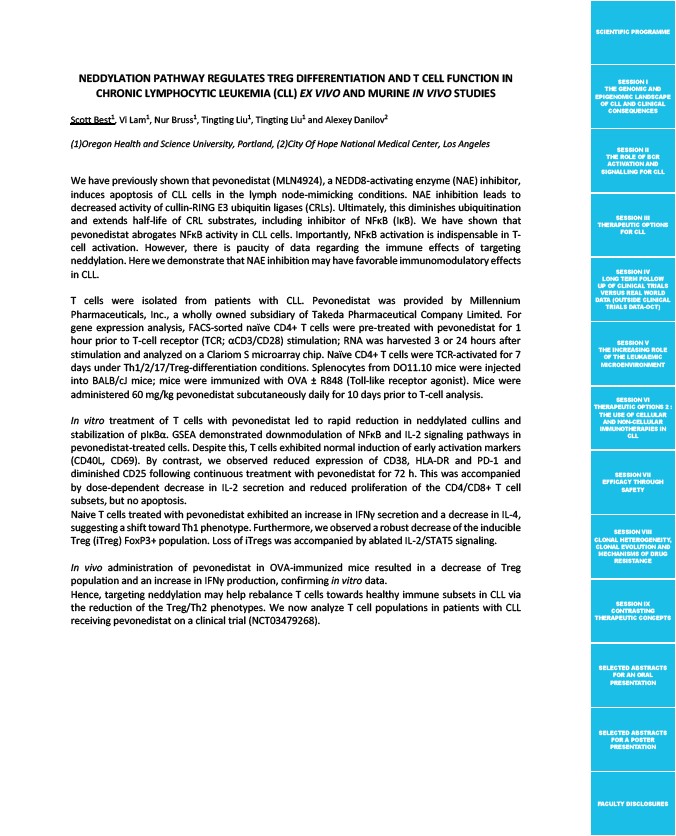
SCIENTIFIC PROGRAMME
SESSION I
THE GENOMIC AND
EPIGENOMIC LANDSCAPE
OF CLL AND CLINICAL
CONSEQUENCES
SESSION II
THE ROLE OF BCR
ACTIVATION AND
SIGNALLING FOR CLL
SESSION III
THERAPEUTIC OPTIONS
FOR CLL
SESSION IV
LONG TERM FOLLOW
UP OF CLINICAL TRIALS
VERSUS REAL WORLD
DATA (OUTSIDE CLINICAL
TRIALS DATA-OCT)
SESSION V
THE INCREASING ROLE
OF THE LEUKAEMIC
MICROENVIRONMENT
SESSION VI
THERAPEUTIC OPTIONS 2 :
THE USE OF CELLULAR
AND NON-CELLULAR
IMMUNOTHERAPIES IN
CLL
SESSION VII
EFFICACY THROUGH
SAFETY
SESSION VIII
CLONAL HETEROGENEITY,
CLONAL EVOLUTION AND
MECHANISMS OF DRUG
RESISTANCE
SESSION IX
CONTRASTING
THERAPEUTIC CONCEPTS
SELECTED ABSTRACTS
FOR AN ORAL
PRESENTATION
SELECTED ABSTRACTS
FOR A POSTER
PRESENTATION
FACULTY DISCLOSURES
NEDDYLATION PATHWAY REGULATES TREG DIFFERENTIATION AND T CELL FUNCTION IN
CHRONIC LYMPHOCYTIC LEUKEMIA (CLL) EX VIVO AND MURINE IN VIVO STUDIES
Scott Best1, Vi Lam1, Nur Bruss1, Tingting Liu1, Tingting Liu1 and Alexey Danilov2
(1)Oregon Health and Science University, Portland, (2)City Of Hope National Medical Center, Los Angeles
We have previously shown that pevonedistat (MLN4924), a NEDD8-activating enzyme (NAE) inhibitor,
induces apoptosis of CLL cells in the lymph node-mimicking conditions. NAE inhibition leads to
decreased activity of cullin-RING E3 ubiquitin ligases (CRLs). Ultimately, this diminishes ubiquitination
and extends half-life of CRL substrates, including inhibitor of NFκB (IκB). We have shown that
pevonedistat abrogates NFκB activity in CLL cells. Importantly, NFκB activation is indispensable in T-cell
activation. However, there is paucity of data regarding the immune effects of targeting
neddylation. Here we demonstrate that NAE inhibition may have favorable immunomodulatory effects
in CLL.
T cells were isolated from patients with CLL. Pevonedistat was provided by Millennium
Pharmaceuticals, Inc., a wholly owned subsidiary of Takeda Pharmaceutical Company Limited. For
gene expression analysis, FACS-sorted naïve CD4+ T cells were pre-treated with pevonedistat for 1
hour prior to T-cell receptor (TCR; αCD3/CD28) stimulation; RNA was harvested 3 or 24 hours after
stimulation and analyzed on a Clariom S microarray chip. Naïve CD4+ T cells were TCR-activated for 7
days under Th1/2/17/Treg-differentiation conditions. Splenocytes from DO11.10 mice were injected
into BALB/cJ mice; mice were immunized with OVA ± R848 (Toll-like receptor agonist). Mice were
administered 60 mg/kg pevonedistat subcutaneously daily for 10 days prior to T-cell analysis.
In vitro treatment of T cells with pevonedistat led to rapid reduction in neddylated cullins and
stabilization of pIκBα. GSEA demonstrated downmodulation of NFκB and IL-2 signaling pathways in
pevonedistat-treated cells. Despite this, T cells exhibited normal induction of early activation markers
(CD40L, CD69). By contrast, we observed reduced expression of CD38, HLA-DR and PD-1 and
diminished CD25 following continuous treatment with pevonedistat for 72 h. This was accompanied
by dose-dependent decrease in IL-2 secretion and reduced proliferation of the CD4/CD8+ T cell
subsets, but no apoptosis.
Naive T cells treated with pevonedistat exhibited an increase in IFNγ secretion and a decrease in IL-4,
suggesting a shift toward Th1 phenotype. Furthermore, we observed a robust decrease of the inducible
Treg (iTreg) FoxP3+ population. Loss of iTregs was accompanied by ablated IL-2/STAT5 signaling.
In vivo administration of pevonedistat in OVA-immunized mice resulted in a decrease of Treg
population and an increase in IFNγ production, confirming in vitro data.
Hence, targeting neddylation may help rebalance T cells towards healthy immune subsets in CLL via
the reduction of the Treg/Th2 phenotypes. We now analyze T cell populations in patients with CLL
receiving pevonedistat on a clinical trial (NCT03479268).